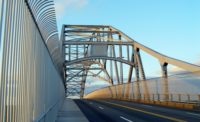The Trump Administration and Congress could be in for a huge construction price shocker if and when they ever pass sweeping legislation to overhaul the country’s infrastructure, a pair of studies suggest.
Adjusted for inflation, the cost of federal highway construction tripled by the time the rollout of the interstate system, which kicked off in the 1950s, was completed in the early 1990s, a new study by the Brookings Institution finds.
And the main contributors to the price increase – rising home prices and rising incomes – could very well play a role in pushing up the cost of a federal infrastructure program, should one be passed, the study’s authors say.
“There could be similar drivers involved,” said Zachary Liscow, an associate professor at Yale Law School and a co-author of the Brookings study. He was commenting on the connections between the increase in highway spending and the rising cost of infrastructure projects today.
“As people get richer, they want higher quality highways,” added Leah Brooks, a co-author and associate professor of public policy and public administration at George Washington University.
Crunching the numbers, Liscow and Brooks found a three-fold increase in spending per each mile of interstate built by the federal government from the 1960s to the 1980s.
Traditional explanations, such as increasing labor or even increasing land costs, did not generate the kinds of numbers that would account for this dramatic increase, the authors said. Nor was it a product of geography, with planners leaving the most difficult highway spans to the end.
But the two factors that appear to account for the increase in highway costs – and which showed a comparably dramatic increase from the 1960s to the 1980s – were median incomes and home prices across the U.S.
Per capita median incomes doubled during this time period, and, in turn, account for “roughly half of the increase in expenditures per mile over the period,” the study notes. A large proportion of the increase can also be pegged to rising home values, which also ballooned over the two-decade period
“Taken together, income and home value increases account for almost all the temporal change in costs,” the authors wrote.
The “rise of the citizen voice” in the early 1970s, as the modern environmental movement came into its own, is the second major contributing factor the authors found to the rise in highway construction costs during this period.
The combination of rising activism, and a raft of new laws and regulations designed to give the public greater input on major public works projects and development in general, helped set the stage for the big jump in highway construction costs, according to the study.
Empowered as never before by the political, legal and regulatory system, more affluent citizens and homeowners were able to successfully demand changes in proposed highway projects.
“Increases in income led to political demands for more expensive highways, and changes in the legal and political regime led to those making the increased demands having more of a voice,” Liscow said.
In keeping with this theory, federal highway projects built in the later years of the rollout of the interstate featured “more ancillary structures” than before, with more bridges and more ramps. Sound barriers were built more often, too.
Environmental also issues became a major discussion point from the 1970s on as highway projects were debated and planned, with roadways built during the latter years featuring “more wiggly routes” detouring around various areas.
The New Jersey Experience
"Just building the sound walls alone could explain the increase," Brooks said, adding that "they are pretty expensive."
Meanwhile, local government bureaucracy can also drive up the cost of highway construction and maintenance, a new study out of New Jersey finds.
The Garden State overspends by as much as $2 billion on highway projects each year due to inflated bureaucracy and outdated planning, a report by the Garden State Institute finds.
While it spends roughly $11.5 billion a year on transportations and infrastructure, New Jersey’s road and bridge network gets only a D+ from the American Society of Civil Engineers.
The study blames the high cost and low quality of New Jersey’s highway and transportation infrastructure on a complicated system in which county and local governments control large swaths of the roads in the state.
All told, the vast majority of roads in the Garden State are under local (74%) and county (17%) control, the study noted.
“New Jersey spends over $238,000 per state-controlled lane mile, the highest among the states analyzed,” the study notes.
The only state anywhere close to New Jersey in highway spending is Massachusetts, which forks over $197,000 per lane mile.
“The data is clear that, in general and in relative terms, New Jersey far exceeds other states with respect to how much it costs to run, maintain, and build its highways,” the study finds.






Post a comment to this article
Report Abusive Comment